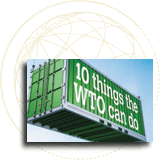10 The WTO can ... be effective without hitting the headlines
Negotiations and disputes are news-makers, but a lot of vital WTO work takes place out of the limelight to help trade flow smoothly, for the benefit of the world economy and for all of us.
The WTO can ...
...cut living costs and raise living standards
...settle disputes and reduce trade tensions
...stimulate economic growth and employment
...cut the cost of doing business internationally
...encourage good governance
...help countries develop
...give the weak a stronger voice
...support the environment and health
...contribute to peace and stability
...be effective without hitting the headlines
The negotiations are over. The chairperson has gavelled the deal through. Ministers have signed it. Parliaments have ratified it. It’s taken years and now most of the media have left.
But for the WTO and its member governments, this is just the start.
The deal consists of the agreements or “rules”. They aim to help bring us safe food to eat, a good choice of clothing to wear and telephone services with which to call our friends and relatives, and effective medicines at affordable prices. WTO rules can even make it easier to have fun travelling or being entertained in our own homes.
WTO agreements can only do that if they are put into practice effectively — they have to be implemented and monitored. Years of essential, unglamorous work lie ahead.
What governments have agreed to put into practice includes:
— lower trade barriers
— trimming red tape in customs and trade
— justifications for restricting imports on health, safety and environmental grounds that are rational, not arbitrary
— disciplines on how they can react when imports increase sharply or the prices of imports tumble
— limits on harmful agricultural subsidies
— access to services markets
— intellectual property protection.
They also want to know that other countries are keeping their promises too — that’s a right in addition to their own obligations to keep to the rules. And often they want to see how other countries are putting the rules into practice because they can learn from each other.
Much of this work is technical and detailed. It involves countries sharing information with each other and with the public, on anything within the WTO’s scope, from “anti-dumping” investigations to labels listing food ingredients, from copyright law to measures taken to combat bird flu.
It also includes opportunities for countries to comment on each other’s actions and sometimes to influence the final outcome.
In the WTO’s first 16 years, governments sent in over 10,000 “notifications” just on their regulations for food safety and animal and plant health — very detailed, very technical, but very important for specialists, essential for trade and for health.
This does not make headlines — when it works, few people notice. When there is a problem, that’s when it becomes news. So when the WTO is not in the headlines, it’s likely that things are going well, at least as far as day-to-day trading is concerned.
That, in a nutshell is what the WTO’s routine work is about. Without it, the negotiations would be pointless.
The WTO process
